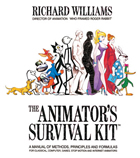BOOK REVIEW:
Last year saw the biggest number of animations hitting our
local cinemas in recent years. With the inclusion of Academy
Awards for Best Animated Film just a few years ago and the
increasing number of production companies working on animations,
it’s safe to say that animation will be remain a popular
medium of storytelling for at least a few years to come.
But behind all the fanciful 3-dimension work of art that’s
flooding our screens and not matter how advance the animator
‘s technologies gets, the most important aspect of animation
is still the very basic foundation of animating. In Richard
Williams, the director of animation of “Who Framed Roger
Rabbit”’s The Animator’s Survival Kit, it’s
all about getting down to basic.
Starting from a seemly trivial thing that some animators do
while animating (or even anyone while doing their respective
craft such as report /essay writing), Richard Williams recollects
on how he tried to shared his choice of music to listen to
while animating, resulting in a memorable lesson in concentration
while animating (or other form of crafts) that I cant help
but agreed to.
It might seem strange and trivial but it’s not. This
is just one of the many interesting tidbits of lifelong experience
in animation that Richard Williams shared with us in this
book. Unless you had those years of working in animation,
all this information should proved to be an eye opener for
casual readers and extremely helpful for those who are thinking
of starting in this field.
Richard Williams’ intention for this book was that it
could be used as a handy reference guide that’s clear
and straightforward. As a casual reader who wants to know
a little more than what’s being offered in the cinemas
and with almost no experience in animating, The Animator’s
Survival Kit was as easy and interesting book to read.
For example, concept of inbetween and the extreme of animated
characters were presented in numerous simplified illustrations
that are simple to understand. While it slowly progress to
the more intricate details of animation, the same method of
explanation remains and even if you were to flip past a few
chapters, it’s unlikely you would encounter any difficulties
in understanding what that chapter is trying to say.
CHOICE XCERPT:
“Animation is just doing a lot of simple things –
One at a time! A lot of really simple things strung together
doing one part at a time in a sensible order.
This book is an anatomy course in animation. Just like an
anatomy course in life drawings, it shows you how things are
put together and how they work. This knowledge frees you to
do your own expression.”
VERDICT:
If after reading this book makes you want to borrow a copy
of “Bambi”, “Jungle Book” or “Who
Framed Roger Rabbit”, you are not alone. Going through
this book makes one appreciate and respect the art of animation
even more. You will know that every simple motion that the
animated character does in animation are not that simple after
all.
   
Review
by Richard Lim Jr
|

